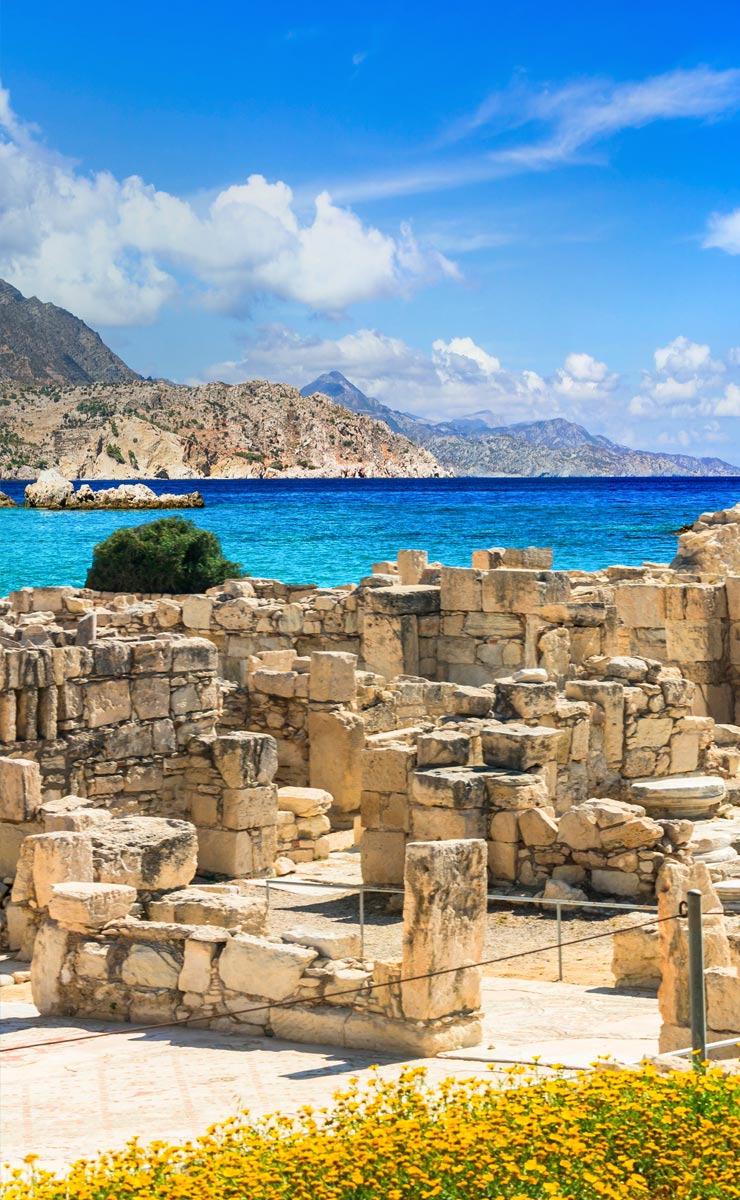Cyprus- A Green-Gold Leaf Cast Upon the Sea
This leaf-shaped island, tucked into the northeast corner of the Mediterranean, about 75 km south of Turkey and 100 km west of Syria and Lebanon, is not, strictly speaking, Greece. It is its own country. But it is Hellenic to its core, and has been ever since the Mycenaeans first showed up 2,400 years ago. Cypriots are fond of referring to mainland Greece as their "mother."
Cyprus is remembered beautifully by poet Leonidas Malenis as a "green-gold leaf cast upon the open sea," a poem set to music by the great Greek composer Mikis Theodorakis ("Zorba") in a moving tribute to a divided island:
Land of the lemon and the olive tree
land of warm embraces, land of joy
land of the pine and the cypress tree
land of fine young men, land of love
Greece and Cyprus share the same language (although Greek Cypriot as a dialect differs in some respects from Modern Spoken Greek), watch the same Greece-based TV networks, and even share the same national anthem, the stirring "Hymn to Liberty" by Greek national poet Dionysios Solomos.
Cyprus was known as "Kittim" or "Chittim" in the pre-Homeric period of the Old Testament, and "Kition" by the Egyptians around 1150 BC. Cyprus first got her name during the time of Homer, around 800 BC. It was part of the Eastern Orthodox Byzantine empire from the 4th to the 16th century, and then was part of the Ottoman Empire for 3 centuries, from 1571-1878. It was during that time that Turks settled on Cyprus. Cyprus figures heavily in the New Testament book of Acts, and was toured by the Apostle Paul and Barnabas, his traveling companion, along the south coast, from Salamis in the east (now in the TRNC), the area of Limassol, and Paphos in the west.
A country of 3 "thirds," Cyprus is the 3rd largest island in the Mediterranean, and the 3rd most populous. The third "third" is not so anodyne: Cyprus's northern third is occupied by Turkey, which has set up a rump government recognized only by the Turks. The population of northern Cyrprus is 300,000 out of a total island population of 1.1 million. The island has been divided since 1974.
If you ever want to go to a place that is culturally English, but climatically and topographically Greek, Cyprus is your best bet. Great Britain leased Cyprus in 1878, and ran things there until the Cypriots gained their independence in 1960. They still drive on the left side of the road, and everyone speaks English. Generally speaking, tourism in Cyprus is run with British efficiency, with a lot of upscale hotels and good service.
Greek Cyprus, which will be referred to from now on as "Cyprus," is a member of the EU and Euro zone. Cyprus is so far south- about even with Crete - that it is a year-round vacation destination. It's both hotter and drier than mainland Greece, with a climate more akin to that of the Middle East. While there is tourism in the Turkish Republic of Northern Cyprus (TRNC), out of 1.1 million visitors in 2012, 904,000 of them were from Turkey, with the rest from Germany, the UK, and Iran.
After Cyprus gained her independence from Britain in 1960, there was constant agitation amongst many Greeks and Cypriots for "enosis-" union- with mainland Greece. This came to a head during the reign of the military Junta on Greece (1967-74), when some Cypriots, under the direction of the Junta, tried to force the issue, triggering an invasion of northern Cyprus by Turkey, a near-war between Greece and Turkey, the fall of the Junta, and a division of the island that is still in effect today. Nearly 200,000 northern Greek Cypriots were displaced, removed to the south, while about 60,000 Turkish Cypriots were sent to the north of the island, which was then divided by a UN buffer zone known as the Green Line. The Turkish Republic of Northern Cyprus declared independence. However, the world community views northern Cyprus as Turkish-occupied territory of an EU member state.
Over the years tensions have eased and there are now 7 points of access for tourists from Greek Cyprus to Turkish Cyprus, including 2 by foot in Nicosia (pop. 116,000), the divided capital. It's a unique opportunity to experience two completely different cultures in close proximity to one another.
Geography and Destinations
Cyprus has a band of mountains running east-west, with a couple National Parks. Its highest peak is Mt. Olympus, at nearly 2,000 meters. There is also an elevated ridge along the north coast, whose highest point is Kyparissavouno (Mt. Cyprus), elevation 1,024 meters. There are plains along the coast, and a central plain named Mesaoria. Cyprus is a favorite stopping off point for migratory birds flying the Europe-North Africa route.
Popular tourist destinations in Cyprus include Paphos, capital of the District in west Cyprus of the same name. Paphos, founded around 1500 BC, is home to the Tombs of the Kings, a necropolis built into a cliff face overlooking the sea and dating from the 4th century BC. The tombs, carved out of living rock, were burial sites for aristocrats and the rich, but probably not for kings. Paphos is also considered the birthplace of the goddess Aphrodite, goddess of love, sex and beauty. One of Aphrodite's ancient names is "Kypris," named after Cyprus. Paphos also has the ruins of a Byzantine castle. There are many well-preserved mosaics from the Hellenistic era. This city of 27,000 It has a nice old harbor, with hotels and restaurants all along it beautiful promenade.
Limassol, 2nd-largest city on Cyprus (pop. 101,000), capital of the District of the same name, is a place that has something for everyone: beaches, night life, archeology, and museums. It's located in about the center of the south coast of Cyprus. Limassol was known as Neapolis during the Byzantine era, and is built around the Limassol Castle, which dates from the Middle Ages. Limassol is sited between 2 ancient cities, Amathus and Curium, which very likely were visited by the Apostle Paul and Barnabas.
The Limassol Wet 'n Wild Water Park, one of the largest in Europe, has body flumes, slides, inner tube rides, a man-made river, and a kids' pool, not far from the beach. The Time Elevator is a multi-media 40-minute journey through 10,000 years of Cypriot history featuring moveable seats, wind and water. The Municipal Gardens offer shade, and tropical plants. There's a Dinosaur Park for kids, with life-sized models, and a zoo featuring lions, tigers, monkeys, and the native Cypriot wild sheep known as the mouflon, which has a curved, North American bighorn sheep-style rack. Limossol's beach sand has a high silicon content, which is supposed to be good for the skin.
Protaras is located on colorfully-named Fig Tree Bay, a sandy beach on the southeast coast of Cyprus that is rated one of the best in Europe. This blue flag beach is named for the fig trees growing nearby. Agia Napa, just 8 km from Protaras, across the neck of the peninsula of Cape Greco, is home to Cavo Greco National Park, a 385-hectacre preserve with a network of hiking trails, pine and juniper trees overlooking the azure waters of the Mediterranean. The wildlife-filled waters off the cape are a favorite with divers and snorkelers. Agia Napa also has a world-class beach, and with its many beach bars has a reputation of being somewhat of a party town. The area is famous for the Agia Napa sea monster, a legendary ten-headed Cypriot version of the Loch Ness monster.
Nicosia, the capital, in the approximate center of the island, has been inhabited since the Bronze Age (2500 BC), when the plains of Mesaoria were first settled. Being well inland, Nicosia was protected from the constant coastal raids of various pirates and invaders. Notable sieges of Nicosia includes that of Richard the Lionhearted in 1187, and of the Ottoman Turks in 1570. The Turkish siege resulted in 20,000 Cypriot deaths, and the looting of every church and public building.
Nicosia, which, like the island, is divided into 1/3 Turk and 2/3 Greek sectors bisected by the Green Line, has picturesque narrow, twisty streets and many little nooks and corners of interest. The Cyprus Museum has Neolithic, Hellenistic, and Roman artifacts.
Larnaca, 3rd-largest Cypriot city (Pop. 51,000), capital of the Larnaca District, has a palm tree-lined seafront, which fronts the very nice Mackenzie Beach, many bars and cafes with their attendant lively night life, and an interesting medieval fort. The Church of St. Lazarus is named after the man Jesus raised from the dead in the Gospel of John, and who was said to be the first bishop of Kition, which was the ancient city located near Larnaca. The Hala Sultan Tekke ("tekke" means "convent") is a mosque , minaret, mausoleum and cemetery south of Larnaca, on the west bank of the Larnaca Salt Lake. Hala Sultan was the prophet Muhammad's wet nurse. The Tekke is one of the holiest Sufi Muslim and Ottoman shrines.
The Larnaca Salt Lake is 1500 hectares of salt water marsh only about a meter deep. It is home to about 30,000 water birds comprising 85 species including several thousand flamingoes. It's also one of the chief migratory passages on Cyprus. The birds feed off brine shrimp which breed in the lake's waters. The lake fills with water during the winter rains, and dries up during the summer, leaving a scrim of salt and grey dust. The salt used to be harvested and exported.
Fascinating in its history and culture, fun in its beaches and night life, fantastic in its archeology and museums, Cyprus is a year-round destination which offers something to everyone.












